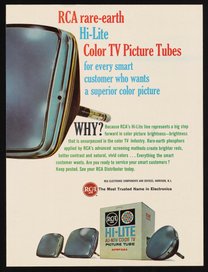How Can a Rose be a Rose be a Rose on Color TV?
- 1964
Color print advertisement for The Sylvania Color Bright 85 picture tube. The advertisement features an image of a picture tube next to a bouquet of roses, with one rose suspended in the center of the screen. The text describes The Sylvania Color Bright 85, which was Sylvania Electronic Components Group's most recent television product at the time. The tube contains a new rare-earth red phosphor using europium as the color agent, providing a balanced and more brilliant television display.
In 1954, the first picture tubes, also known as cathode ray tubes (CRTs), were produced by RCA, but it wasn't until 1963 that the first rectangular color CRTs were offered to the public. Phosphors used in CRTs were classified according to color, persistence, luminance, intended use, chemical composition, safety, and other properties. In 1965, brighter rare earth phosphors began replacing dimmer, cadmium-containing red and green phosphors. Eventually, blue phosphors were replaced as well. Examples of rare earth phosphors are yttrium oxide for red or yttrium silicide for blue.
| Property | Value |
|---|---|
| Creator of work | |
| Contributor | |
| Format | |
| Genre | |
| Medium | |
| Extent |
|
| Language | |
| Subject | |
| Rights | No Copyright - United States |
| Credit line |
|
Institutional location
| Department | |
|---|---|
| Exhibited in |
Related Items
Cite as
GTE Sylvania Incorporated. “How Can a Rose Be a Rose Be a Rose on Color TV?” Paper (fiber product), 1964. Science History Institute. Philadelphia. https://digital.sciencehistory.org/works/nyv9c8h.
This citation is automatically generated and may contain errors.





